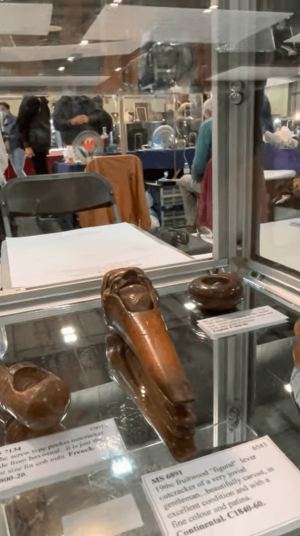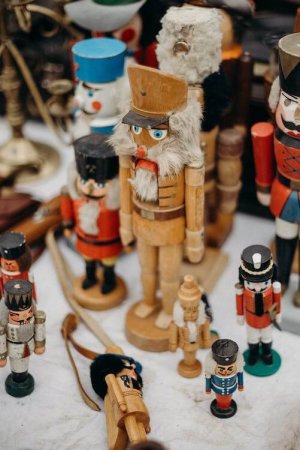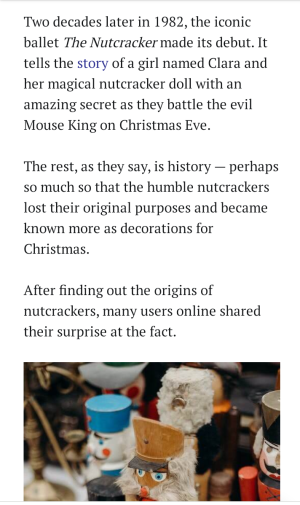The real purpose of nutcrackers...
- Replies 11
Nutcrackers were, and still are, one of the most popular Christmas decorations.
Whether they’re on your shelf or a part of the decorations thrown up on your tree each year, it’s likely that you have at least seen these fascinating little figures around during the holidays.
Traditionally designed to resemble toy soldiers donning buttoned blazers and top hats, we've come to recognise them so much that lots of people actually forget what their true purpose was in the first place.
Have you ever wondered how nutcrackers got their name?
The answer is surprisingly simple: they were actually used to crack nuts!
You might have a grimace on your face right about now, thinking ‘Well… duh.’
Pardon us for the shock, but you have to admit: We rarely see these decorations outside of being used as ornaments, so it was quite a surprise to find out the history behind their name!

Apparently, it all started way back when English and French woodworkers began creating delicately carved sculptures resembling humans and animals during the early 15th century.
Its modern incarnation didn't get manufactured until the early 1700s when versions more similar to the ones we know today started being made in Germany.
In 1872, these nutcrackers were commercialised when Wilhelm Füchner, the credited Father of Nutcrackers (for those of you who chuckled, let it all out…), created a fanciful version based on Heinrich Hoffmann's story King Nutcracker and Poor Reinhold.
Two decades later in 1892, the iconic ballet The Nutcracker made its debut. It tells the story of a girl named Clara and her magical nutcracker doll with an amazing secret as they battle the evil Mouse King on Christmas Eve.
The rest, as they say, is history — perhaps so much so that the humble nutcrackers lost their original purposes and became known more as decorations for Christmas.
After finding out the origins of nutcrackers, many users online shared their surprise at the fact.

‘Oof (I) genuinely didn’t know that nutcrackers crack nuts. I'm sobbing right now,’ one said.
A second one chimed in, ‘Nutcrackers are actually used to crack nuts… I was today years old.’
And a third one that captures our disbelief best exclaimed: ‘NUTCRACKERS ACTUALLY CRACK NUTS?! (WHAT) SINCE WHEN.’
If you found this surprising, wait till you see what can openers were made for… Kidding!

On the topic of things you might not have known, do you know the story behind the iconic Celebrations chocolates name and logo? Check this story out if you don’t!
What is your reaction to this story? Are you among those surprised by this seemingly obvious revelation? Or was the name of these humble Christmas ornaments a dead giveaway?
Share your thoughts and opinions below!
Source: YouTube/Cuckoo Forest
Whether they’re on your shelf or a part of the decorations thrown up on your tree each year, it’s likely that you have at least seen these fascinating little figures around during the holidays.
Traditionally designed to resemble toy soldiers donning buttoned blazers and top hats, we've come to recognise them so much that lots of people actually forget what their true purpose was in the first place.
Have you ever wondered how nutcrackers got their name?
The answer is surprisingly simple: they were actually used to crack nuts!
You might have a grimace on your face right about now, thinking ‘Well… duh.’
Pardon us for the shock, but you have to admit: We rarely see these decorations outside of being used as ornaments, so it was quite a surprise to find out the history behind their name!

This antique nutcracker is an example of earlier ones made that took on human and animal designs. Screengrab Credit: YouTube/iacf
Apparently, it all started way back when English and French woodworkers began creating delicately carved sculptures resembling humans and animals during the early 15th century.
Its modern incarnation didn't get manufactured until the early 1700s when versions more similar to the ones we know today started being made in Germany.
In 1872, these nutcrackers were commercialised when Wilhelm Füchner, the credited Father of Nutcrackers (for those of you who chuckled, let it all out…), created a fanciful version based on Heinrich Hoffmann's story King Nutcracker and Poor Reinhold.
Two decades later in 1892, the iconic ballet The Nutcracker made its debut. It tells the story of a girl named Clara and her magical nutcracker doll with an amazing secret as they battle the evil Mouse King on Christmas Eve.
The rest, as they say, is history — perhaps so much so that the humble nutcrackers lost their original purposes and became known more as decorations for Christmas.
After finding out the origins of nutcrackers, many users online shared their surprise at the fact.

The origins of these popular Christmas ornaments are unknown to some. Stock Image Credit: Pexels/cottonbro studio
‘Oof (I) genuinely didn’t know that nutcrackers crack nuts. I'm sobbing right now,’ one said.
A second one chimed in, ‘Nutcrackers are actually used to crack nuts… I was today years old.’
And a third one that captures our disbelief best exclaimed: ‘NUTCRACKERS ACTUALLY CRACK NUTS?! (WHAT) SINCE WHEN.’
If you found this surprising, wait till you see what can openers were made for… Kidding!
Key Takeaways
- Nutcrackers have been a common Christmas decoration, but many people are shocked to discover that they are actually used to crack nuts.
- Nutcrackers have been around since the 15th century, with their modern design coming from German woodworker Wilhelm Füchtner in the 19th century.
- The Nutcracker ballet, which debuted in 1892, is widely attributed for why nutcrackers are now associated with Christmas.
What is your reaction to this story? Are you among those surprised by this seemingly obvious revelation? Or was the name of these humble Christmas ornaments a dead giveaway?
Share your thoughts and opinions below!
Source: YouTube/Cuckoo Forest








